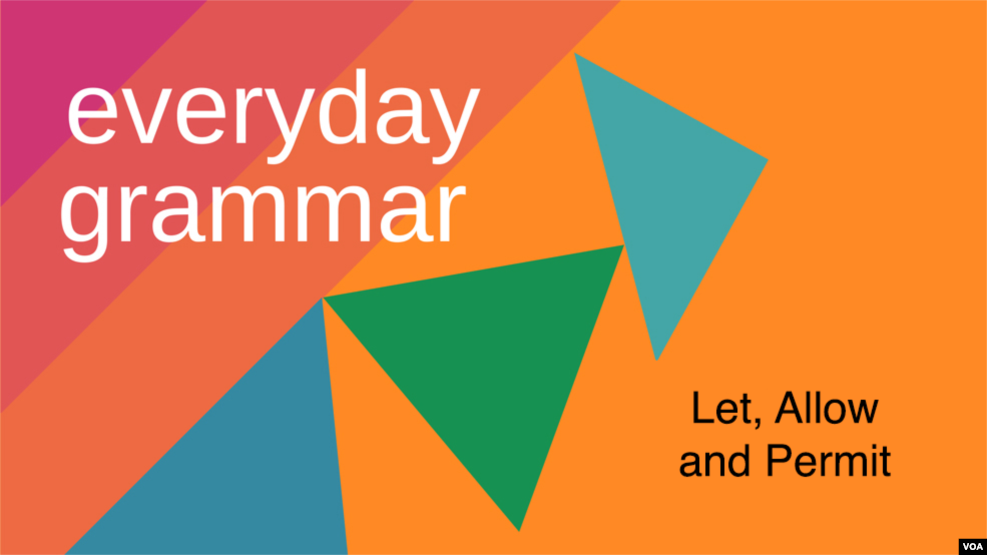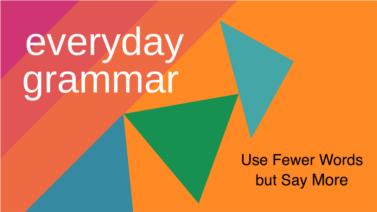
The verbs “let,” “allow” and “permit” are part of a group of verbs called “causatives.” These verbs express how one person or thing causes something else to happen. For instance, if I said, “She let me borrow the book,” the subject (she) is not the person who borrowed the book. Instead, she caused someone (me) to borrow it.
In a past Everyday Grammar program, we told you about the causative verbs “make,” “get” and “have.” Today, we will tell you about “let,” “allow” and “permit” – three verbs that deal with permission.
These verbs are synonyms - words with very close meanings. They mean:
- to give permission to someone or something to do something or
- to make it possible for someone or something to have or do something
Making causatives
We will look at each verb. But let’s begin by talking a little bit more about causatives.
In a causative sentence, the subject does not perform the action of the main verb. Instead, the subject (a person or thing) causes the action to happen to the object (another person or thing).
Causative sentences start with a subject, followed by a causative verb, then an object and then the main verb. Think of it as X causing Y to do something.
How to use Let
Okay, now let’s talk about “let.” It is the most informal of the three verbs.
Listen to some examples and make a note of which sentences are about possibility and which are about permission.
You will also hear that the main verbs – go, enjoy and cook – are in simple form. The simple form is the most basic form of a verb without “to” before it or “s” at the end. Have a listen:
I let my children go to the game every week.
The warm days let us enjoy the end of summer.
Let the vegetables cook for about 20 minutes.
How to use Allow
Now, let’s look at “allow.” It is more formal than “let” but less formal than “permit.” You can use it in everyday situations. You may also find it in official rules, such as street, building and office signs.
With “allow,” we use the infinitive form for main verbs. The infinitive form is “to” plus the simple form of the verb.
In the following examples, make a note of the meaning of “allow” in each. Which sentences are about permission? Which are about possibility? And, note the use of infinitive main verbs:
My teaching skills allow me to help English learners.
Her parents do not allow her to eat beef.
They do not allow us to smoke in the building.
You may have noted that two examples are in the negative form. When talking about rules, we often use “allow” in the negative to say what people must not do.
The passive form
Now, let’s take a quick break to talk about the passive form, an important form for these verbs. The verbs “allow” and “permit” are often used in passive sentences.
You may remember our past programs on passive voice.
In a passive sentence, the subject is acted upon, or receives the action of the verb. The subject is often not mentioned in the sentence.
When we speak or write about official rules, we often use passive voice. Let’s hear the smoking rule again, this time in the passive:
Smoking is not allowed in the building.
The person or people who made the rule are not mentioned because it is not relevant to the statement.
How to use Permit
Now, onto “permit” – the most formal of the three verbs.
We use it for everyday rules, such as those of a family. We also use it when talking about making things possible.
But, in American English, “permit” is more common in sentences about official rules, such as in signs and handbooks that state what you are not permitted to do.
And, like “allow,” we use the infinitive form for main verbs with “permit.” Listen for the infinitives in these examples:
Her parents do not permit her to eat beef.
The city does not permit pets to ride the Metro.
The zoo does not permit visitors to feed the animals.
Again, for official rules, we often use passive voice. Let’s hear two of the examples as passive:
Pets are not permitted to ride the Metro.
Visitors are not permitted to feed the animals.
Imagine these as public signs. Most public signs are not complete sentences. What you often will see is very short wording, such as “smoking not permitted.”
It is important to note that not all sentences with “let” “allow” and “permit” follow the causative sentence structure.
Well, I hope you enjoyed letting me tell you all about these causative verbs today.
I’m Alice Bryant.
Alice Bryant wrote this story for Learning English. Caty Weaver was the editor.
Practice
Now, you try it! Practice using today’s causative verbs. Read the instructions below and do the exercises.
Exercise 1
During today’s program, I asked you to make a note of the meanings in the example sentences. Which sentences were about giving permission? Which were about making something possible? Write your answers in the comments area.
Exercise 2
Answer the following questions in complete sentences. Be sure to use causative sentence structure. You can use the table below as a guide. Write your answers in the comments area.
Example:
Question: Does your job let you take a lunch break?
Answer: Yes, my job lets me take a lunch break.
(Or) No, my job does not let me take a lunch break.
Did the changes permit you to have more free time?
Will you let me pay for dinner tonight?
Does the museum allow visitors to take pictures?
Do your parents allow you to drive their car?
Should we let the dog run around the park?
Does your school permit students to eat in class?
| subject | causative verb | object | main verb |
|---|---|---|---|
| The warm days | let | us | enjoy… |
| Her parents | (do not) allow | her | to eat… |
| The zoo | (does not) permit | visitors | to feed… |
Words in This Story
informal - adj. not suited for serious or official speech and writing
formal - adj. suitable for serious or official speech and writing
negative - adj. referring to a word or statement that means “no” or that expresses a denial or refusal
mention - v. to talk about, write about or refer to something or someone, especially in a brief way
handbook - n. a small book of instruction or guidance on a subject
pet - n. an animal, such as a dog, cat, bird, or fish, that people keep mainly for pleasure


